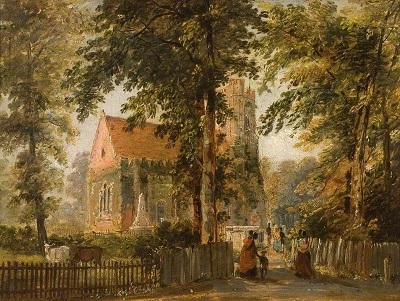The Old Brick Church of Great Stanmore, was described in 1951 by Nikolaus Pevsner in his book ‘The Buildings England’ as: one of the finest ruins in the county of Middlesex and if it could talk what a story it could tell. Steeped in nearly 400 years of history, it is the final resting place for one of our former prime ministers, The Earl of Aberdeen, whose many efforts and successes including determining the border between Canada and the U.S.A.
It was paid for by Sir John Wolstenholme, a merchant adventurer who was a founder member of the East India Company. It was decorated by such an august a personage as Nicholas stone, master stone mason to Charles I, and It cost the Archbishop of Canterbury his life, as he was beheaded for treason. These days this Grade II* listed highly picturesque ruin, is of great architectural importance as an example of Caroline classicism, showing the impact of Inigo Jones, one of the greatest English Renaissance architects.
The Saxon Church
It is thought that the earliest religious building in Stanmore was a Roman sanctorum, a common site in Roman Britain, usually built by crossroads they served as a public meeting point as well as a place of worship. Like a large part of the ancient world, Romans believed that spirits of the dead gathered around crossroads. It was therefore common to find a small shrine, or compita, set up wherever paths or roads met. These would have four altars to honour the spirits in each direction. Early in the fifth century as the sprawling Roman Empire stared to crumble, Britain was considered a far-flung outpost of little value, the Roman armies were repatriated as they were needed back home to defend Rome. Across Britain, Saxons replaced the Roman stone buildings with their own wooden ones, and here was no exception, as the Roman shrine was replaced by a small wooden Saxon church. This Saxon church was situated down what is now known as Old Church Lane, near to the junction of Wolverton Road, it lasted in various forms until C1300 when a larger, more permanent structure was built.
The Medieval Church
This new place of worship ‘The Medieval Church’ was dedicated to St. Mary although it was known locally as the 'Church of our Lady' and was built sitting on the left bank of the Stanburn stream outside of the moat surrounding the Stanmore manor house. St. Marys was built in two stages, the original building was constructed with an aisle-less nave, about thirty-four feet long, and the west gable, was supported by a pair of diagonal buttresses. As the congregation expanded in the fifteenth century so did the church, the nave was lengthened to forty-five feet by moving the west wall with its buttresses nearer the stream. A new chancel was built, the same width as the nave, thus virtually making the church one large hall seventy-four feet long and twenty-two feet wide. Fragments uncovered by builders laying a service road for the Stanmore Village Railway in 1892 showed the medieval church location although these days no trace survives, apart from the tomb of Baptist Willoughby, who was church rector from 1563 until 1610, in the garden of Haslemere no. 44 Old Church Lane. The only artefact from the church to survive, is the Burnell monument, which is housed in the modern parish church.
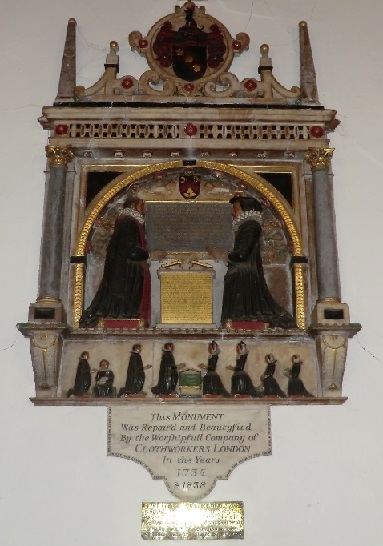
the only artefact to have been housed in the Saxon, Brick and modern parish Church.
The Brick Church
By the early seventeenth century, a large percentage of the population of Great Stanmore had moved about a mile north of the medieval village and settled alongside the main road, near to the bottom of what is now Green Lane, so the decision was taken to build a new church on a more convenient site, to the north of Colliers Lane, now known as Rectory Lane. The church was built in 1632 on land that was donated by three local parishioners: The Lady of the Manor, Mrs Barbara Burnell, widow of a wealthy cloth merchant, Sir Thomas Lake of Canons and Mr Robinson. The whole project was bankrolled by Sir John Wolstenholme, a freelance customs official, pioneer and adventurer who founded the ‘Council of the Virginia Company’ of North America.
Exterior
The church was built, classical in design of red bricks which were made locally, each one measuring 9 x 4 x 2 which were laid in alternate courses of headers and stretches a popular decorative style at the time known as English Bond. Built to last, the thickness of the walls in some places were over two feet thick, the entire project using some 250,000 bricks. A three-stage bell tower was built, reinforced later with massive diagonal brick buttresses on the outer west wall. The nave is 65 x 36 feet and there was no chancel, so the nave directly faced the altar on the east wall. Most of the windows are round-headed and the Venetian window in the east wall resembles those in the Queen's Chapel, an early occurrence of this feature. The structure was not completely built of brick, there was a porch in Portland stone on the south side, which unfortunately has not survived. Portland stone was also used as dressing around the west door. These stone dressings are attributed to Nicholas Stone, an architect and master stone mason to Charles I, he was the chap responsible for the building of Inigo Jones' Banqueting House in Whitehall, although one of his first commissions was from Sir John Wolstenholme, for our brick church at Stanmore.
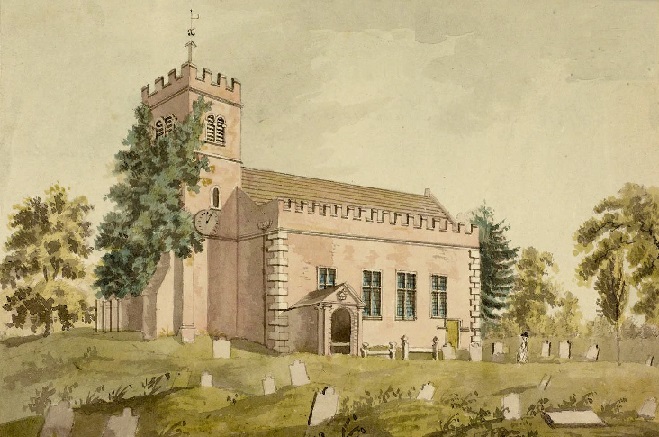
architect and master stone mason to Charles I.
Sir John Wolstenholme
The church was financed by Sir John Wolstenholme. Wolstenholme a self-made man was born in Stanmore in 1562 in the old manor house where his parents lived. When he left school, he began his career working for the custom house in Barking. In 1604, a decision was taken to lease out the administration of Custom dues in return for an annual rent. This ‘farming out’ of Custom dues attracted a large number of very wealthy men who clearly felt that they could make a great deal of money from them, Wolstenholme being one of them. This role in the privatised Customs and Excise was important to Charles I, as duties provided a source of revenue to King that was outside the control of Parliament. Wolstenholme did extremely well out of this denationalised customs business, and soon Sir John was wielding some considerable political power.
He helped further English commerce, by twice financing Henry Hudson and William Baffin’s expeditions to discover a North-West passage to India in 1610 and 1615. In recognition for this funding, Hudson named the Eastern point of the great Hudson Bay 'Cape Wolstenholme'. Baffin immortalized him in ‘Wolstenholme Sound’, now known as Wolstenholme Fjord on the west coast of Greenland and 'Wolstenholme Island.
The British Empire was quite possibly the greatest source for good that the world has ever known, and this Empire started in Virginia, as it was here that the first colony of the British Empire was founded. So, it was a fitting tribute to the man that in 1618 a settlement in Virginia was given the name of Wolstenholme Towne.
Wolstenholme was knighted in 1617 and became a Justice of the Peace two years later. It was said in later life he brought honour to his birthplace, and he certainly put Stanmore firmly on the map.
Sir John died in December 1639, the inscription on his monument, now in the present church beneath the pulpit, says that he died 'alas all too young' when nearly eighty years of age. He is also remembered, here in Stanmore as he is immortalised in a stone effigy kept in the present church, this wonderful piece was also the work of master stone mason, Nicholas Stone.
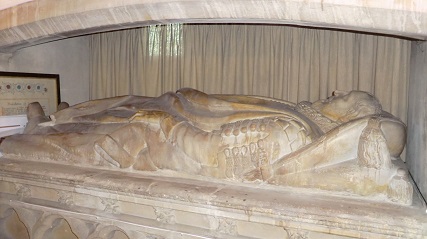
now housed on the modern parish church
William Laud
The church was consecrated on 17 July 1632 by William Laud, the Bishop of London, who in 1633 was to become Archbishop of Canterbury. This consecration was an act that was to become his undoing in later years because, as the building was paid for by Sir John Wolstenholme it would later be denounced by the Puritans as a private chapel.
For nearly a century before Charles reign very few churches had been built and only six were built in the whole of the reign of Queen Elizabeth I, which lasted forty-four years. This was all about to change and under Laud's influence there was a marked increase in the building of churches for public worship and also private chapels built as the result of private initiatives. William Laud gave the Church of England much of the distinctive character it has today, but he was unfairly accused of having Roman Catholic sympathies, a dangerous position given the religious tensions of the time. His other detriment was that he was a close confidant of Charles I, and giving the king secular assistance when he governed without Parliament also made him unpopular.
When a Scottish army crossed the border in 1639, and attacked north-east England occupying the coalfields near Newcastle, Charles I was unable to muster an army capable of countering this invading force, and so was forced to recall Parliament after an 11-year recess to raise funds to counter the Scots. MPs were in an unforgiving mood and used the financial weakness of the king to extend their political powers. They demanded control over the king’s ministers, and Laud was their first target. Lauds enemies accused him of “Popery.” However, it was the broad concept of “Laudism” that most aroused fear and anger. It seems Laud most angered the older generation of the time, and it was these senior MP’s who sat on the Long Parliament that led the campaign against Laud, his policies, and the King. The Long Parliament of 1640 accused Laud of treason, and, in the Grand Remonstrance of 1641, called for his imprisonment. He was arrested for High Treason on 1 March 1641 and on 12 May, eighteen months before the Civil War broke out was imprisoned in the Tower of London.
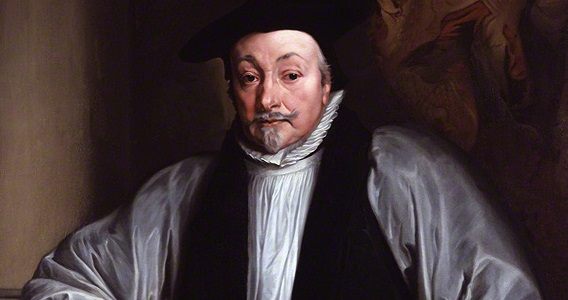
Laud remained in the Tower throughout the early stages of the English Civil War. He was charged with High Treason and one of the charges against him concerned the nature of the ceremonies he used during the consecration of the church at Stanmore. The prosecutor claimed that the church was Sir John Wolstenholme's private chapel, but William Laud refuted this.
In these early days Parliament showed little anxiety to proceed against him, indeed, given his age, most MPs would probably have preferred to leave him to die of natural causes, and for some time he was left unnoticed in the Tower. On 31 May, the puritan William Prynne who had himself been arrested on the orders of Laud a few years earlier, received orders from the parliament to search his papers, and published a mutilated edition of his diary. The trial was inconclusive but the House of Commons passed an Ordinance of Attainder, an arbitrary procedure to find him guilty of trying to subvert the laws of England and endangering the Protestant faith, they also coerced the House of Lords to do the same.
It is known that at Laud's trial one of the charges brought against him was that he 'outwent Popery in the consecration of Chapels', and the accusers referred to the 'chapel of Sir John Wolstenholme’s building'. To this Laud replied that "Stanmore was no chapel but a true parish church". Although he was granted a royal pardon in April 1643, it was to no effect and William Laud was beheaded in 1645. four years before his sovereign met the same fate.
The new Church
By 1845 the brick church had become too small for the increasing population of Stanmore and was also thought to be structurally unsafe due to the make-up of the ground around the church which was substantially made of sand and gravel, four additional buttresses had been added to give further support to the bell tower, and a fifth to support the north-west corner of the nave they also considered extending the Brick church but the cost of doing so it would have been almost as expensive as building a new one.
So on the 17th of October 1848 it was decided that a new church was going to be built next to the old one, on an adjacent field donated by Col. Hamilton Tovey Tennent, who lived in a large mansion in Green Lane. This new church is the present-day church of St. John the evangelist and was built between 1848-50. It was designed by Henry Clutton and built in Kentish Rag and Bath Stone in the Victorian 'early decorated' style. The new church contains many of the memorials from the old church, which were moved here. The foundation stone was laid in the presence of Queen Adelaide, who was then living at Bentley Priory, and this turned out to be her last public appearance. The new church was consecrated by the Bishop of Salisbury on 16 July 1850, having cost £7,855 0s 3d, paid for through subscriptions and donations, including £1,000 from the Rector, Revd. Douglas Gordon, the son of Lord Aberdeen, who himself made a donation of £2,000.
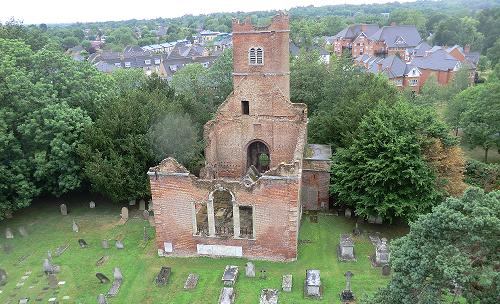
Demolition
As the parish now had a nice new church, authority was obtained to demolish the brick one. So, on the 24th of February 1851 work started, artefacts were removed and taken to the new church, the roof was dismantled, and part of the south wall was demolished; and then a local outcry from the people of Great Stanmore prevented the work from continuing.
Hollond Mausoleum
From 1850 the nave of the church was used for burials and one of the most impressive memorials is the grand mausoleum of the Hollond family. This grandiose display of Victorian wealth was built in 1867 of red sandstone, limestone and marble by Robert Hollond for himself and his family. Hollond was the seventh son of William Hollond of the East India Company. In his youth, he became interesting in flying and achieved fame by flying his balloon from Vauxhall Gardens across the English Channel and safely landing in the town of Weilburg, in Germany. In 1837, he became a member of Parliament for Hastings. Three years later Hollond married his wife Ellen, and they lived together in Stanmore Hall, until Robert’s death in 1877. Ellen was well known in her own right as an authoress and philanthropist. She opened a nursing home in Paris and established the first creche in London in 1854. She died at Stanmore Hall in 1884 and joined her beloved Robert in the family tomb.
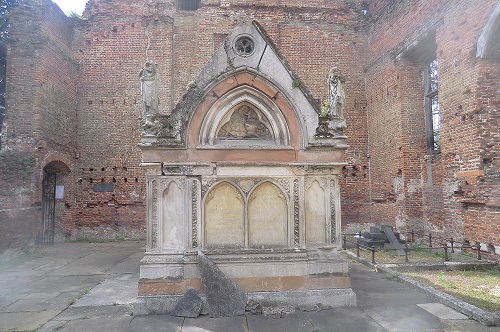
Beneath the old church on the north side was the Bentley Priory Vault and among those buried here were Lord Abercorn and Lord Aberdeen, George Hamilton Gordon, 4th Earl of Aberdeen who had married Lord Abercorn's daughter and was Prime Minister under Queen Victoria from 1852-55. His coffin was only rediscovered following works to make safe the old church in the early 1990s, when retired Stanmore GP Freddie Hicks aimed his camera inside and the flash lit up the coffin. Many parishioners who supported and served the church throughout the centuries are remembered in the memorials and ledger slabs which have been retained and placed inside the tower. there are several tablets of the late 17th and early 18th centuries, but most of the more elaborate monuments have been moved to the new church. The interior was paved over with stone flags in 1992.
Fundraising and English Heritage
During the 1980’s the state of the brick church was getting worse both with the damage caused by the ivy which had now consumed the building as well as the tower, and vandalism. Both St John's and its insurers became worried about the ruin's stability and their liabilities. After fund-raising in St John's and in Stanmore, and with generous support and technical advice and assistance from English Heritage, the consolidation was conducted between 1991 and 1993.
As a result, the ruin has now been made safe with little change in its appearance, apart from the removal of the ivy. Subsequent to the Working Group meeting, a steeplejack was commissioned to remove all the extraneous foliage growing from the walls and take a digitised photographic record. The Morton Partnership were commissioned to carry out a Structural Survey—which fortunately concluded that although many cracks had appeared, the overall integrity of the building was secure to allow visitors to attend the Old Church.
The ladder to the Bell Tower was checked and signed off and new harnesses were bought. When the Great Stanmore Old Church Working Group was formed in 1989 and appealed for funds The Royal family donated included Her Majesty Queen Elizabeth, Queen Mother and Her Royal Highness Princess Anne. The appeal was extremely successful, and in all, over £250,000 was raised.
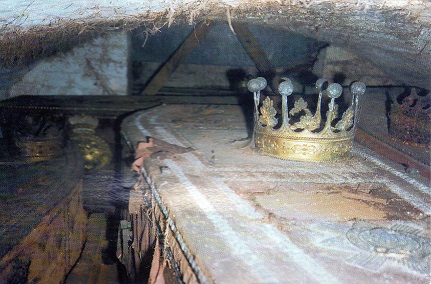
The Future
From 1632 the brick church of St John's served the community of Great Stanmore. In 2016 a project was mooted by ‘The Old Church Working Group’ who met representatives from English Heritage, now Historic England, and Harrow Council Conservation and Planning Department to look at an idea to restore the old church back to being a usable building. Various design solutions were considered, including a new timber beamed roof to sit below the restored parapet. Thus, giving the impression from the outside that a roof was not present. This proposal would been designed by a specialist contractor. A very ambitious project that may or may not happen, and who knows, one day the old Church may well serve the people of Stanmore once again.
Open and visit
The church is open to the public, for viewing on a number of Saturdays from April to September during the hours of 2.00 to 4.00 PM, there is always someone on hand to show you around and answer any questions you may have about the building and its history.
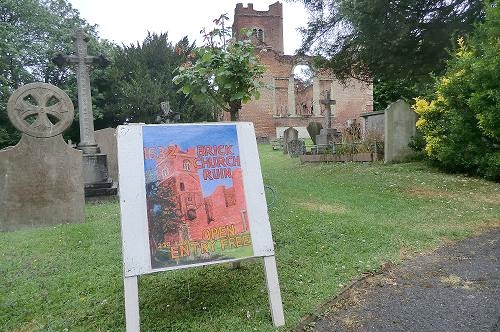
during the hours of 2.00 to 4.0 PM
It is situated in a large churchyard which has a number of interesting features including a Lych gate, given to the church by the eminent Victorian railway engineer Sir John Kelk. Dotted around the grave yard are notable tombs of Charles Keyser, founder of the Colne Valley Water Company, Col. Mark Beaufoy, Governor of Harrow School and the first Englishman to climb Mont Blanc, Frederick Gordon, the world’s greatest hotelier and chairman of the Harrow & Stanmore railway, the librettist and poet W S Gilbert, The Naturalist Eliza Brightwen, England cricketer Vernon Royle and William Knox D’arcy founder of the Anglo Persian Oil Co. later to become British Petroleum.
The old Church is free to enter although donations are appreciated for the upkeep of this beautiful Grade II listed building.
Visitors are welcome to the Ruin, and is open for viewing between April and September from 2.00 to 4.00 PM. the dates are listed below:
Due to the COVID-19 outbreak, visits inside the ruined church for 2021 are currently suspended until further notice.
